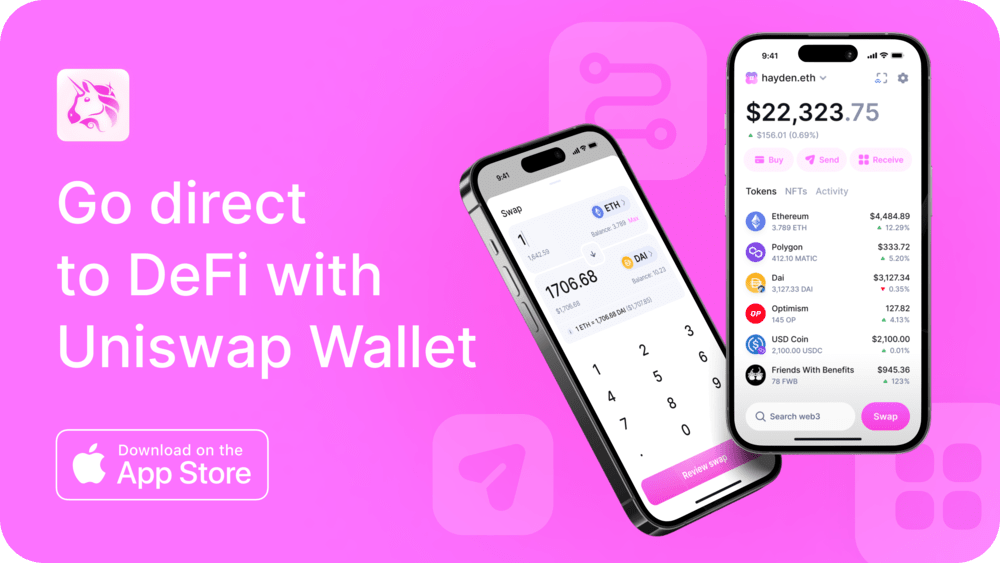Dear Bankless Nation,
Every week, the BanklessHQ analyst team gets together and discusses what's happening in the markets and where the alpha is. Sometimes, the opportunities we're watching feel a little too risky to share widely.
But today, we're surfacing 8 degen-only investment plays that we're eyeing – available in full exclusively to our paying subscribers.
- Bankless team
8 Risky Plays that We’re Watching
Bankless Writer: Jack Inabinet | disclosures

Often, the best plays in crypto appear a little degenerate.
Risk and reward are positively correlated, meaning opportunities with the highest potential for upside naturally tend to be discovered by those testing the highest degrees of risk.
Today, we’re covering eight opportunities designed to intrigue your inner degen! Each protocol listed has a token – or promises one is coming extremely soon – but all are likely to send risk-averse investors and users running for the hills…
Take note: this guide is for DEGENS ONLY 🦍
🪐 Unibot
Website | Twitter
Sector: Trading Bot
Market Cap: $161.0M
Ticker: UNIBOT
What is it?
Unibot is the dominant “Telegram Trading Bot” by market cap according to CoinGecko. It allows users to interface with Uniswap from Telegram and improves on the traditional DEX experience, offering users features for limit orders, copy trading, MEV protection, pre-order slippage tests, and sniping newly created tokens (with honeypot protection).
The protocol charges a variable transaction fee, between 0.6% to 1%, of which the Unibot shares 40% – along with a 1% tax on traded UNIBOT volumes – back to token holders.
Why it’s a degen play:
Whether a Telegram bot truly represents an improvement in the trading user experience remains up for debate, but UNIBOT’s sudden rise to prominence is a clear indication of potential within the sector. Volumes and active user metrics on Unibot are pumping, propelling protocol fees alongside them! Investment in UNIBOT is certainly risky, but perhaps the protocol’s rise to fame has just begun.
We’re very hesitant to recommend the usage of a product that requires you to ⚠️ turn over private keys ⚠️ to an internet bot, but if you can manage your degen risk, Unibot appears to offer an attractive feature set that could provide the tools you need to spot and enter winning trades.
🔵 Conic Finance
Website | Twitter
Sector: Yield
Market Cap: $8.8M
Ticker: CNC
What is it?
Conic Finance is a yield protocol on Ethereum built on top of Curve that introduced single asset liquidity pools called Omnipools. The deposited asset, say USDC, is allocated by Conic across one or more Curve pools that use the pool’s underlying token. A portion of the Curve pool LP tokens are restaked to Convex.
Holders of Conic native token, CNC, can lock it with the protocol to receive vlCNC to direct liquidity allocation weights of the Curve pools used by an Omnipool in bi-weekly liquidity allocation votes (LAV). CNC is emitted to boost yields for LPs that stake their Omnipool LP tokens and to incentivize deposits during a rebalance period, which occurs after an LAV.
Why it’s a degen play:
When there’s blood in the streets, perhaps it's time to buy? Conic Finance suffered a 1.7k ETH ($3.6M) hack from its recently deployed ETH Omnipool on July 21, and saw three quarters of its TVL ($113M) vanish over successive days, meaning it could be time to scoop some discounted CNC.
Despite the major setback, the Conic Finance team remains committed to the project and announced it will attempt to further harden Omnipools against drainage attacks, by prohibiting users from depositing and withdrawing in the same block to prevent flash loan exploits and by increasing the dynamism of Omnipools to reduce hard-coded heuristics.
🔵 Penpie
Website | Twitter
Sector: Yield
Market Cap: $2.1M
Ticker: PNP
What is it?
Penpie is a DeFi platform designed to provide Pendle Finance users with yield and veTokenomics boosting, servicing Pendle’s users in a similar capacity to what Convex does for Curve users.
Users can vote-lock their PENDLE for mPENDLE through Penpie to maximize the APR that they earn. Penpie uses these deposits to establish a bribe market that enables vlPNP holders to influence PENDLE emissions, creating a capital efficient route for interested parties to purchase influence over Pendle’s emissions over short periods of time.
Additionally, Penpie allows liquidity providers to Pendle to take advantage of its amassed vePENDLE holdings to access boosted yields without needing to lock PENDLE themselves. Boosted yield from liquidity farming is distributed between the LPs (83%), mPENDLE stakers (12%), and vlPNP holders (5%).
Why it’s a degen play:
While Penpie has seen fairly continuous inflows since DefiLlama began tracking the protocol’s TVL in early June, further appreciation of PNP price is contingent on the continued dominance of Pendle and rising popularity for DeFi interest rate swap applications.
Accessing boosted yields as a Pendle liquidity provider on Penpie is not without risk either, as users must assume an additional layer of smart contract risk on top of Pendle.
🟡 Lodestar
Website | Twitter
Sector: Lending
Market Cap: $1.6M
Ticker: LODE
What is it?
Lodestar is a fork of the popular lending protocol Compound that has carved out a niche providing markets for an exotic range of Arbitrum-based assets. The protocol’s mission is to bring decentralized lending to blossoming Arbitrum communities in hopes of creating new value for DAOs and their token holders. Lodestar currently services the Treasure, Dopex, and Plutus ecosystems.
The LODE token represents its holder’s share of the Lodestar DAO and gives them governance control over the platform. Holders are also entitled to a portion of platform fees, paid out in ETH, but are diluted by LODE token emissions used as liquidity and borrow/lend incentives.
Why it’s a degen play:
Lodestar is essentially a high-risk, low market cap play on top of Arbitrum ecosystem protocols. Demand for the protocol will increase with a rise in the level of speculative fervor for the unique assets it provides markets for, which should translate to value for LODE holders. Beyond making a direct investment in LODE, you could use the protocol to take out a loan against or go leveraged long on the Treasure, Dopex, and Plutus ecosystems!
Go direct to DeFi with the Uniswap mobile wallet. Buy crypto on any available chain with your debit card. Seamlessly swap on Mainnet and L2s. Explore tokens, wallets and NFTs. Safe, simple self-custody from the most trusted team in DeFi.
🟢 Euler
Website | Twitter
Sector: Lending
Market Cap: $51.3M
Ticker: EUL
What is it?
Euler offered a variety of improvements on traditional decentralized lending markets, like Aave. One of the protocol’s most exciting features was permissionless market creation for any asset with a WETH pairing on Uniswap V3, meaning Euler could offer markets on practically any asset!
Given the increased risk profiles of long-tail assets, Euler took a variety of steps to mitigate risks, including implementation of governance-controlled asset tiers and a two-sided approach to assess users’ risk-adjusted borrowing capacity.
Why it’s a degen play:
Tragically, Euler suffered a $200M loss from a flash loan attack in March and despite recovering a majority of user funds, the protocol forced users to cash out and temporarily suspended operations. You can’t use Euler today, but the frontend notes that “Euler.finance is coming back soon” and advises viewers to “check back later in the year.” Euler Labs is also currently hiring!
It appears that the Euler ecosystem will be returning in full force in 2023 and seems likely users will receive a safer, redesigned product! Investing in EUL requires a leap of faith, but allocating now could help you front-run the waves of hot money and users that may follow upon the protocol’s planned relaunch.
🟣 Ajna Finance
Website | Twitter
Sector: Lending
Market Cap: N/A
Ticker: AJNA
What is it?
Ajna Finance is a governance-minimized lending protocol that does not depend on external price feeds, like an oracle. The protocol enables the creation of permissionless lending markets for any ERC-20 (fungible tokens) and permissionless borrow markets for any ERC-20 and any ERC-721 (NFTs).
Instead of relying on oracles, Ajna uses an internal order book that makes lenders set the value of their assets. Ajna can be accessed through third-party interfaces, like Summer.fi.
Why it’s a degen play:
Oracle-less lending protocols are much riskier than their oracle-dependent, bluechip counterparts (e.g.; Aave and Compound), as the smart contracts developed have less Lindy, but they do get rid of some risk eliminating dependencies on external price feeds.
While Ajna’s smart contracts are largely untested by time, becoming an early user will soon allow you to earn AJNA token emissions. Once AJNA is freely tradable, you’ll be able to purchase ownership in a protocol with a radically innovative take on lending!
⚫ LineaBank
Website | Twitter
Sector: Lending
Market Cap: N/A
Ticker: LAB
What is it?
LineaBank is the largest money market by TVL on Linea, the zero-knowledge rollup from ConsenSys that opened to users last week at EthCC! While the protocol’s token is not yet live, users who supply assets to or borrow from prior to August 11 will receive a LAB allocation thanks to LineaBank’s pre-mine campaign.
Holders of LAB can lock up their token with LineaBank for up to one year to receive numerous benefits, including boosted yields on supplied assets and claims on protocol revenues. LAB token emissions are used to incentivize lending and borrowing activity, in addition to providing an additional yield source for LAB lockers. As an additional benefit to governance token holders, the protocol will also use its revenues to buy back and burn LAB.
Why it’s a degen play:
Trusting freshly deployed Compound forks with your money is certainly risky business, but LineaBank is the one of the clearest routes to get early exposure to the Linea ecosystem.
We’ve seen the TVL of competitive tokenless L2s, like zkSync, explode. Linea enjoys native integrations with ConsenSys products, like MetaMask, increasing the likelihood that users will flood to the chain’s mainnet. If they do, it appears that LineaBank would be well-positioned to serve as a primary money market of the burgeoning Linea ecosystem.
🟣 Umami
Website | Twitter
Sector: Yield
Market Cap: $10.1M
Ticker: UMAMI
What is it?
Umami offers yield products structured around GMX’s liquidity share, GLP. This month, the protocol shipped its V2 and delivered a major upgrade: Deconstructed GLP Vaults, which allow yield farmers to target their asset exposure while retaining exposure to the high yields that GLP offers. Umami also introduced internal netting in this recent upgrade, vastly reducing the cost of delta hedging.
UMAMI holders can marinate their tokens to receive a portion of protocol fees paid out in WETH. Compounding, an alternative to marinating, further boosts stakers rewards by swapping the WETH for additional UMAMI and restaking it.
Why it’s a degen play:
Before Umami’s core GLP yield product even went live, UMAMI hit its ATH. Despite the lack of protocol revenues at this time, stakers could marinate their tokens for yield paid out by the treasury. This blissful period for UMAMI holders lasted until late January, when the project abruptly fell from stardom after it turned off the yield (citing regulatory concerns) and its CEO subsequently dumped his tokens.
Hot money may have migrated away from Umami, but the protocol has shipped a quality product that yield farmers can use to get targeted delta exposure to GLP yield! UMAMI is also a high beta GMX play and we expect the protocol to receive further TVL inflows and usage should GLP yields improve or GMX gains broader adoption.
Action steps
- 👁️ Review the State of Ethereum Q2 2023 Report
- 🌠 Catch up on our primer 8 NFTs That Will Survive
Check out ETHx 🧪

